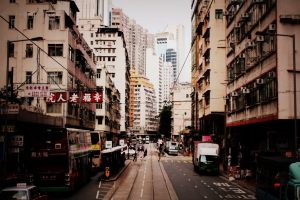
What’s Left of Murakami’s Tokyo?
by Thalia Roychowdhury | December 22, 2022
As I arrived at Narita Airport, my head was filled with images of Haruki Murakami’s Tokyo. I imagined stepping out of my taxi to meet smoky jazz bars, bell pepper spaghetti, and Kafka-esque cityscapes. Instead, I confronted a globalised urban sprawl. Canned pop music echoed across the streets and beaming billboards lit up every street corner. 24-hour restaurants and convenience stores were never more than a few metres away. In the post-Olympics era, Tokyo took great pains to clean itself up, becoming an unabashed centre for tourism. It is hard now to imagine the landscapes that Murakami so lovingly writes about: the scrappy city of the 1970s, overflowing with creativity and intrigue. So, for a while, I put my literary fantasies to bed.
But in a city now populated with Starbucks and profit margins, I found one of the last remaining bastions of Murakami’s fabled Tokyo. An institution kept alive by nostalgia, shaped by over a century of social, political, and literary legacies, the radical heart of Japanese café culture: the kissaten.
Coffee Aristocrat Edinburgh in Shinjuku was my first encounter with a kissaten. The waiters’ uniforms immediately struck me, their neat brown waistcoats and bow ties forming a strange ensemble redolent of a period drama. Every moment I aimlessly sipped away at my latte, the strangeness intensified. A European-style coat of arms arched above me on the wall, flanked by dramatic Renaissance era prints, and lamps shaped as miniature chandeliers illuminated the red brick interiors. It was only my fellow customers – salarymen typing away at laptops and gossiping retirees – that reminded me I was in 21st-century Japan, not an art-deco Viennese café. That, and the jazz rumbling away in the background.
Unlike the bustling, concrete streets that surrounded it, Coffee Aristocrat Edinburgh seemed content to bask in an imagined, European past. But kissaten were not always safe, stuffy cafés. Murakami’s works show that these now unassuming coffee shops were once hubs of social transformation and a defiant youth culture.
Kissaten first emerged in the Meiji era (1868-1912), alongside Japan’s self-styled ‘opening-up’ to the Western world. The early Meiji government reformed its government along European lines, and, with this political emulation came a growing curiosity about Western popular culture. This included the introduction of an exotic new product: coffee. Kissaten imported this enticing taste of Europe, a Japanese facsimile of an imagined Western ideal. However, though Coffee Aristocrat Edinburgh’s name is clearly designed to bring Japanese consumers an enigmatic, vaguely Scottish fantasy, kissa are not concerned with simply emulating the West.
 I realised this as soon as my lunch order arrived. Rather than the classic spaghetti bolognese I had been expecting, the smell of soy wafted from little pink fish eggs perched on my pasta beside pieces of ramen-esque nori seaweed. A bowl of cod-roe pasta, straddling the line between the foreign and the familiar.
I realised this as soon as my lunch order arrived. Rather than the classic spaghetti bolognese I had been expecting, the smell of soy wafted from little pink fish eggs perched on my pasta beside pieces of ramen-esque nori seaweed. A bowl of cod-roe pasta, straddling the line between the foreign and the familiar.
Kissaten accrued their own unique cultural currency in the Showa era (1926-1989). Offering cheap coffee and a place to smoke, they soon began to draw in a burgeoning intellectual class. Students and the mo-ga (modern girls) who scandalised older generation with their adaptation of Western, flapper-style clothing, began to frequent kissa often located near university campuses. In 1926, the unimposing cafés appeared in author Junichiro Tanizaki’s novel, Naomi. Tanizaki uses the titular mo-ga Naomi, and the kissa she frequents, to explore the encroaching Westernisation of the period. As such, kissa firmly entrenched themselves in in Japanese literary culture, becoming a shorthand for the Showa era itself.
Several decades later, Murakami explored the same dynamic of the foreign and the familiar. But in his work, instead of being an exotic Western presence, the kissaten simply form a part of Tokyo’s identity – as they do today. For those in Japan’s capital the West is no longer some alien curiosity but instead a part of everyday life. While I gaped, the other customers of Coffee Aristocrat Edinburgh remained unbothered by the mock-European décor, far more focused on work. Both Murakami’s protagonists and modern Tokyoites casually enjoy spaghetti and jazz records without judgement.
Much like the city itself, Showa-era kissa constantly adapted and evolved to their Tokyoite customers’ tastes, producing the radical subgenre of the jazz kissa . The post-war youth, unable to afford imported records, came to these kissa to listen to the café owner’s curated selection. The master, often the sole employee, not only controlled drinks and snacks but the music selection, an atmosphere far removed from typical, politely distanced Japanese service culture. In my attempts to track one down, I soon realised that these jazz kissa are few and far between nowadays. Their prices have skyrocketed far beyond a student budget, in order to cater to a hardcore jazz connoisseur crowd, banking on nostalgic patronage from an older crowd. But, in the Showa era, these were not elitist spaces. Instead, the social aspect nursed a relationship between customer and kissa-owner – able to discuss jazz in an intimate setting – that evolved beyond transaction.
The literature of Haruki Murakami, who writes of the cafes of his student youth across his oeuvre, memorialises the culture of the jazz kissa. Murakami worked a part time job in jazz kissa, Old Blind Cat, in Shinjuku, and later started his own joint before becoming a writer. His most famous novel, Norwegian Wood, is set amidst the same milieu. Narrated by a student in the heart of 70’s Tokyo, the peak of the kissa scene, the book overflows with jazz kissa, such as Dug in Shinjuku, where the protagonist enjoys a vodka tonic with the daring and free-spirited Midori. During my visit to Coffee Aristocrat Edinburgh, I was finally able to grasp the atmosphere he wrote so longingly about: the rich smell of coffee, a Thelonious Monk record playing in the background, and the gloomy interior’s intimacy, all aspects I had quickly skimmed over on a first glance, the translation merely describing it as a café. I realised Murakami’s Tokyo was never a myth, but was rather a literary resurrection of the past.
 This nostalgia fuelled the unexpected success of Norwegian Wood, striking a chord with the Japanese public. At the time of the novel’s publication in the 80s, a stagnating economy and society led to a widespread disillusionment across the country. Norwegian Wood memorialised the optimistic, intellectually curious Showa era, an age before the financial bubble burst and recession, political stagnation, and Conservatism followed. This was the age of the kissaten. The same wistful longing for the Showa past that made Norwegian Wood a bestseller, undoubtably still ensures the continued existence of kissa in Tokyo’s Shinjuku and Shibuya districts. Murakami’s work solidified the transformation of the kissaten from an exoticised Western curiosity to a uniquely Japanese artifact, symbolising the lost potential of radical Showa student subculture.
This nostalgia fuelled the unexpected success of Norwegian Wood, striking a chord with the Japanese public. At the time of the novel’s publication in the 80s, a stagnating economy and society led to a widespread disillusionment across the country. Norwegian Wood memorialised the optimistic, intellectually curious Showa era, an age before the financial bubble burst and recession, political stagnation, and Conservatism followed. This was the age of the kissaten. The same wistful longing for the Showa past that made Norwegian Wood a bestseller, undoubtably still ensures the continued existence of kissa in Tokyo’s Shinjuku and Shibuya districts. Murakami’s work solidified the transformation of the kissaten from an exoticised Western curiosity to a uniquely Japanese artifact, symbolising the lost potential of radical Showa student subculture.
Kissaten are some of the last personal institutions still found in contemporary Tokyo, recalling a time before Japan’s economic and political stagnation. A modern era where black-suited, overworked salarymen flood out of packed offices into even busier trains, as convenience stores line every street. An era where the inhabitants of near-identical apartments have conditioned themselves to gulp down a chain coffee each day, syrup masking the taste of their overpriced blend. Where the promise of expediency threatens to close the doors of kissa like Coffee Aristocrat Edinburgh – a dying breed of Murakami’s authentic city. But where else can over a century’s worth of complex negotiation, between East and West, personal and transactional, radical and nostalgic, coalesce into an unassuming order of a coffee?
The future of kissaten, while uncertain, is kept alive in literature, and that brief flash of Showa innovation endures for millions of readers, the nostalgic vein still bubbling over. While the real city has long since succumbed to neon-lit commercialisation, those like me, longing to escape into the pages of Norwegian Wood, can still uncover the pockets of Tokyo Murakami so lovingly writes about. Within the kissaten, captured in the pages of his novels, in the minds of millions of readers, Murakami’s Tokyo remains stronger than ever. ∎
Words by Thalia Roychowdhury. Art by Elsie Gray.




